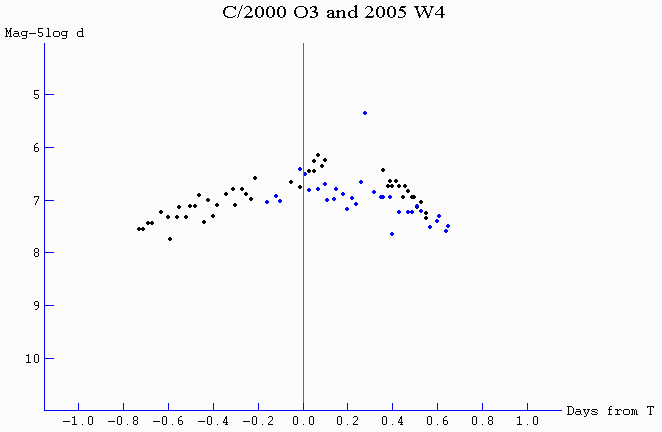
My measurements of C/2000 O3 (black dots) and C/2005 W4 (blue dots) corrected for distance.
While C/2000 O3 passed behind the sun, C/2005 W4 passed in front of it.
Lightcurves including corrections for phase angels
The Return of C/2000 O3 = 2005 W4
The Kracht and the Marsden group comets are most probably related to the short-period comet 96P/Machholz and thus are expected to have orbits of short periods around 5.2 years like 96P. Both groups contain about three dozen individual apparitions observed with SOHO LASCO from 1996 - 2010.
Due to the similartity of the orbits within one group it is not difficult to find pairs of comets with an orbital period of about 5.2 years. This possibility is enhanced by the short observed arcs and the rather large uncertainties of the positions (LASCO pixels are about 12" in C2 and 50" in C3). The only solid identification of one comet with three apparitions was found last year for the Marsden group comet P/1999 J6 = 2004 V9 = 2010 H3 (P = 5.44 to 5.49 years). The identities were supported by the lightcurves measured by M. Knight.
Among the Kracht group comets the pair C/2000 O3 = 2005 W4 was linked by Brian Marsden with P = 5.31 and 5.32 years. The perihelion distances (0.0540 and 0.0546 AU) are the greatest among the Kracht group comets (mean 0.0481 AU) and the orbital inclinations (14.69 and 14.59 deg) are only surpassed by one poorly observed (arc 0.08 days) comet. Both comets were observed in SOHO LASCO C3 and C2 peaking at about mag 6 to 6.5:

My measurements of C/2000 O3 (black dots) and C/2005 W4
(blue dots) corrected for distance.
While C/2000 O3 passed behind the sun, C/2005 W4 passed in front
of it.
Lightcurves including corrections for phase angels
S. Nakano has made a prediction for the return in 2011 with T = 2011 March 10.178.
The comet returned in C3 images of March 09 exactly on the expected track, which was altered by a Jupiter approach to 1.3 AU in 2008. My first measurements in C3 from 07:18 to 11:06 UTC showed a perihelion time of 2011 March 09.84, eight hours earlier than expected. My brightness measurements were between mag 7.2 and 7.6 (about 9 to 13 hours before perihelion / 0.38 to 0.54 days before T). This compares well with the brightness of C/2000 O3 at that time.
The linkage of the three apparitions needs a small nongravitational parameter A2 = -0.0075 as derived with my third order reduction of Karl Battam's measurements. Karl has measured 121 positions from March 09 08:42 to March 10 12:48 UTC. Many of the first observations in C2 are useless (due to a lack of suitable reference stars), but plenty of observations remain to yield a solid orbital solution.
The comet will be visible in the morning sky for southern hemisphere observers in late March/early April. But it's rather uncertain how bright it will then be. One can guess that its diameter is between 10 and 100 meter. The asteroidal absolute brightness could be around mag 24 and the apparent brightness about mag 23 (ignoring phase). That seems to be a difficult object but not for a large telescope, which knows where to look.
Rainer Kracht, 2011 March 20